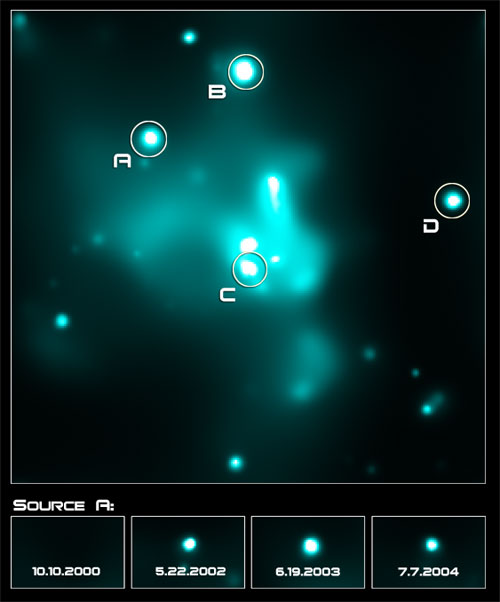Milky Way's Center Packed with Black Holes

SAN DIEGO -- A new study reveals that the center of our Milky Way Galaxy is loaded with black holes, as astronomers have expected in recent years.
The galactic center is dominated by one supermassive black hole. It packs a mass equal to about 3 million Suns. Around it, scientists have expected to find a high concentration of stellar black holes, the sort that result from the collapse of massive stars. Each can be a few to many times the mass of the Sun.
Observations have hinted at the existence of many stellar black holes near the galactic center. But nosing around there is hard, because the region is shrouded in dust. Visible light doesn't escape the region.
The ongoing study, led by UCLA postdoctoral fellow Michael Muno, is searching the inner 75-light-years of the galaxy with the NASA's Chandra X-ray Observatory. X-rays conveniently pierce interstellar dust.
Muno and his colleagues have found strong evidence for seven black holes (they could be neutron stars, which are also very dense). Importantly, four of the objects were concentrated in the inner 3 light-years of space around the supermassive black hole.
"The observed high concentration of these sources implies that a huge number of black holes and neutron stars have gathered in the center of the galaxy," Muno said.
Extrapolating to the whole sky, the finding suggest a swarm of 10,000 black holes and neutron stars orbit near the galaxy's middle.
Get the Space.com Newsletter
Breaking space news, the latest updates on rocket launches, skywatching events and more!
A theory by UCLA's Mark Morris, co-researcher on the new project, predicted the concentration back in 1993. Dense objects like black holes interact gravitationally with less dense stars. The lighter stars tend to get jettisoned outward, Morris figured, while the black holes slow down on their orbital trek around the galactic center, and they sink inward.
The black holes can't be seen directly. Those that are detected have likely taken a companion, a normal star that they devour gradually, the theorists figure. The extended feast also involves a release of X-rays as gas from the normal star is superheated until it glows before plunging beyond the point of no return.
The findings were reported here at a meeting of the American Astronomical Society. More research is needed to confirm the conclusions, the scientists said.
- Scientists Pinpoint Milky Way Galaxy's Black Hole
- Surprising Second Black Hole Found in Milky Way's Center
- Where The Action Is: Heart of Milky Way Unveiled
Join our Space Forums to keep talking space on the latest missions, night sky and more! And if you have a news tip, correction or comment, let us know at: community@space.com.

Rob has been producing internet content since the mid-1990s. He was a writer, editor and Director of Site Operations at Space.com starting in 1999. He served as Managing Editor of LiveScience since its launch in 2004. He then oversaw news operations for the Space.com's then-parent company TechMediaNetwork's growing suite of technology, science and business news sites. Prior to joining the company, Rob was an editor at The Star-Ledger in New Jersey. He has a journalism degree from Humboldt State University in California, is an author and also writes for Medium.









